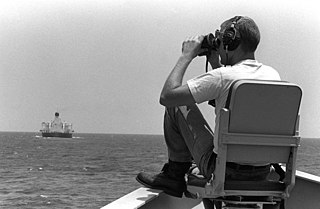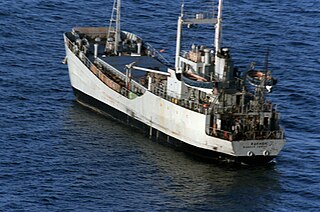
The Strait of Hormuz is a strait between the Persian Gulf and the Gulf of Oman. It provides the only sea passage from the Persian Gulf to the open ocean and is one of the world's most strategically important choke points. On the north coast lies Iran, and on the south coast lies the Musandam peninsula, shared by the United Arab Emirates and Musandam Governorate, an exclave of Oman. The strait is about 90 nautical miles (167 km) long, with a width varying from about 52 nmi (96 km) to 21 nmi (39 km).

USS Boxer (LHD-4) is a Wasp-class amphibious assault ship of the United States Navy. She is the sixth U.S. ship to bear the name of the original HMS Boxer, which was captured from the British during the War of 1812.

Iran and the United States have had no formal diplomatic relations since 7 April 1980. Instead, Pakistan serves as Iran's protecting power in the United States, while Switzerland serves as the United States' protecting power in Iran. Contacts are carried out through the Iranian Interests Section of the Pakistani Embassy in Washington, D.C., and the US Interests Section of the Swiss Embassy in Tehran. In August 2018, Supreme Leader of Iran Ali Khamenei banned direct talks with the United States.

The Fifth Fleet is a numbered fleet of the United States Navy. It has been responsible for naval forces in the Persian Gulf, Red Sea, Arabian Sea, and parts of the Indian Ocean since 1995 after a 48-year hiatus. It shares a commander and headquarters with U.S. Naval Forces Central Command (NAVCENT) in Bahrain. Fifth Fleet/NAVCENT is a component command of, and reports to, U.S. Central Command (CENTCOM).

USS Samuel B. Roberts (FFG-58) is one of the final ships in the United States Navy's Oliver Hazard Perry-class of guided missile frigates (FFG). Commissioned in 1986, the ship was severely damaged by an Iranian mine in 1988, leading U.S. forces to respond with Operation Praying Mantis. Repaired and returned to duty, the ship served until decommissioned in 2015.

Operation Earnest Will was the American military protection of Kuwaiti-owned tankers from Iranian attacks in 1987 and 1988, three years into the Tanker War phase of the Iran–Iraq War. It was the largest naval convoy operation since World War II.

Operation Praying Mantis was an attack on 18 April 1988 by the United States Armed Forces within Iranian territorial waters in retaliation for the Iranian naval mining of international waters in the Persian Gulf during the Iran–Iraq War and the subsequent damage to an American warship.

In military strategy, a choke point, or sometimes bottleneck, is a geographical feature on land such as a valley, defile or bridge, or maritime passage through a critical waterway such as a strait, which an armed force is forced to pass through in order to reach its objective, sometimes on a substantially narrowed front and therefore greatly decreasing its combat effectiveness by making it harder to bring superior numbers to bear. A choke point can allow a numerically inferior defending force to use the terrain as a force multiplier to thwart or ambush a much larger opponent, as the attacker cannot advance any further without first securing passage through the choke point.

Strike Fighter Squadron 15 (VFA-15) was an aviation unit of the United States Navy, based at Naval Air Station Oceana. The squadron was in service from 1 August 1968 to 31 May 2017, although the squadron had adopted the traditions of the first VA-15, which was established on 10 January 1942. The unit's nickname was "Valions" and its call sign was Pride.

Iran Ajr, formerly known as the Arya Rakhsh, was a Japanese-built landing craft used by Iran to lay naval mines during the Iran–Iraq War. Built in 1978, the 614-ton, 54-meter ship was powered by two diesel engines and featured a bow ramp for unloading cargo. She was scuttled in 1987.

The Iranian Navy traditionally located in the shallow waters of the Persian Gulf, has always been the smallest of the country's military forces. An Iranian navy in one form or another has existed since Achaemenid times in 500 BC. The Phoenician navy played an important role in the military efforts of the Persians in late antiquity in protecting and expanding trade routes along the Persian Gulf and Indian Ocean. With the Pahlavi dynasty in the 20th century that Iran began to consider building a strong navy to project its strength into the Persian Gulf and Indian Ocean. In more recent years, the country has engaged in domestic ship building industries in response to the western-backed Iraqi invasion of Iran, which left it without suppliers during an invasion.

The Navy of the Islamic Revolutionary Guard Corps is the naval warfare service of the Islamic Revolutionary Guard Corps founded in 1985, and one of the two maritime forces of Iran, parallel to the conventional Islamic Republic of Iran Navy. The IRGC has been designated as a terrorist organization by the governments of Bahrain, Saudi Arabia and the United States. IRGC's Navy has steadily improved its capabilities to support unconventional warfare and defend Iran's offshore facilities, coastlines, and islands in the Persian Gulf.
Anti-Iranian sentiment or Iranophobia, also called anti-Persian sentiment or Persophobia, refers to feelings and expressions of hostility, hatred, discrimination, or prejudice towards Iranian people on the basis of an irrational disdain for their national and cultural affiliation. The opposite phenomenon, in which one holds notable feelings of love or interest towards Iranian people for the same reasons, is known as Iranophilia or Persophilia.

Ghadir is a class of midget submarines built by Iran specifically for cruising within the shallow waters of the Persian Gulf. The Islamic Republic of Iran Navy is the sole operator of this class, whose all submarines serve in the Southern Fleet. No submarine of this class is active at the Northern Fleet, i.e. the Caspian Sea.

Qasem Soleimani was an Iranian military officer who served in the Islamic Revolutionary Guard Corps (IRGC). From 1998 until his assassination in 2020, he was the commander of the Quds Force, an IRGC division primarily responsible for extraterritorial and clandestine military operations. In his later years, he was considered by some analysts to be the right-hand man of the Supreme Leader of Iran, Ali Khamenei, as well as the second-most powerful person in Iran behind him.

Iran and Saudi Arabia are engaged in an ongoing struggle for influence in the Middle East and other regions of the Muslim world. The two countries have provided varying degrees of support to opposing sides in nearby conflicts, including the civil wars in Syria and Yemen; and disputes in Bahrain, Lebanon, Qatar, and Iraq. The struggle also extends to disputes or broader competition in other countries globally including in West, North and East Africa, South, Central, Southeast Asia, the Balkans, and the Caucasus.
Farhad Azima is an American airline operator.

On 3 January 2020, Qasem Soleimani, an Iranian major general, was targeted and killed by a U.S. drone strike near the Baghdad International Airport in Iraq while he was on his way to meet Iraqi Prime Minister Adil Abdul-Mahdi.

Esmail Qaani is an Iranian brigadier general in the Islamic Revolutionary Guard Corps and commander of its Quds Force — a division primarily responsible for extraterritorial military and clandestine operations. Leader of Iran Ali Khamenei appointed Qaani to succeed Qasem Soleimani as Commander of the Quds Force.
Abdolreza Shahlaei is an Iranian military officer with the rank of brigadier general who serves as the commander of the Yemen division of Quds Force of the Islamic Revolutionary Guard Corps.

















